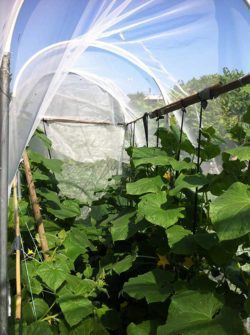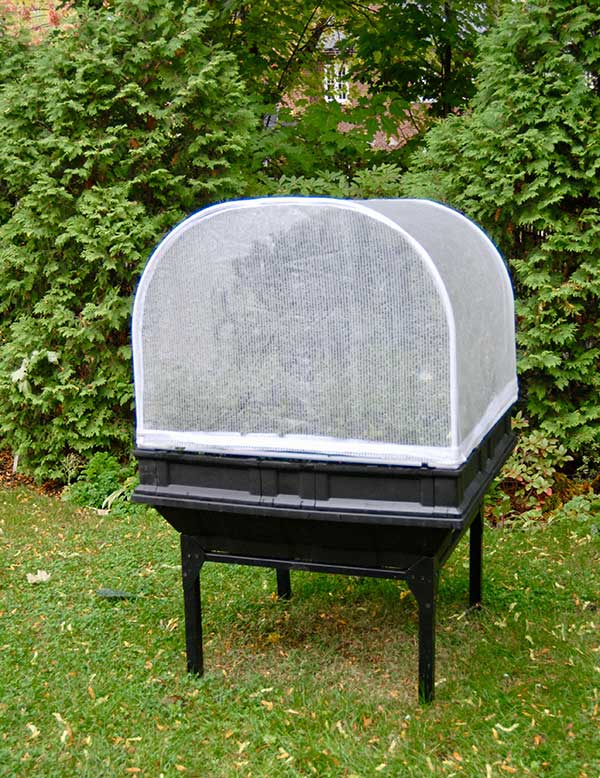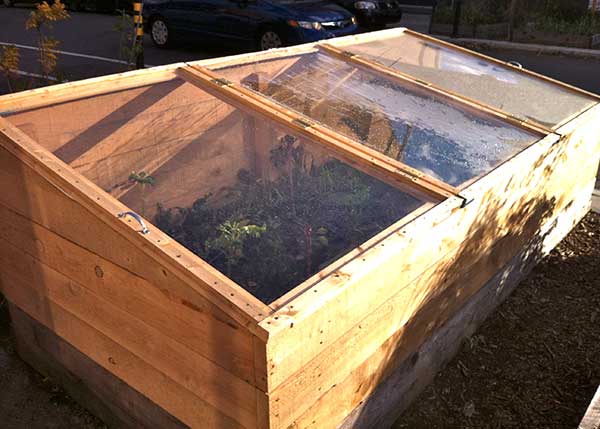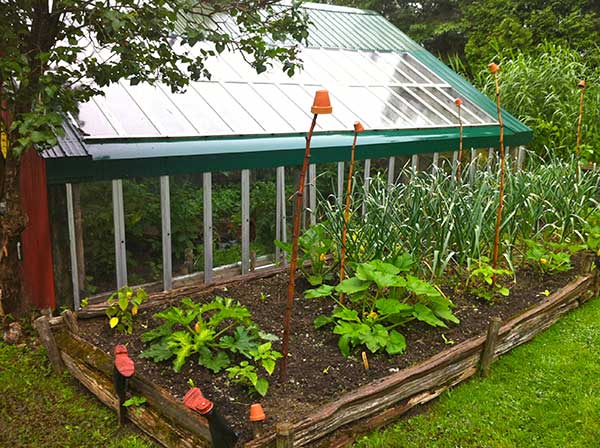Although 16 of the last 17 years are considered to have been the warmest since climate data was made available, the fact remains that winters in Canada and the northern United States are harsh.
This reality forces urban farmers to start their season only once the snow melts and the ground thaws. Also, most edible plants that are grown outdoors stop producing and die with the arrival of autumn frosts.
However, with some simple and effective protection techniques, it is possible to start the growing season earlier and extend the harvest period by a few weeks.
Agrotextiles
Agrotextiles are white, veil-like textiles used primarily to protect crops against insects and bird attacks while allowing sunlight to reach the plants for photosynthesis.
Some agrotextiles are insulating and help maintain a temperature of about 5 °C (41°F) more than the ambient air. For example, at an outside temperature of -4 °C (25°F), plants covered by an agrotextile are not affected by frost.

In addition to being protected from the cold during spring nights, cucumbers planted under a small shelter covered with an agrotextile are not affected by the striped cucumber beetle, a vector of various diseases. With this technique, the harvest of cucumbers can be extended until the end of summer, sometimes even until the beginning of autumn.
In the northeastern United States and southeastern Canada, the use of agrotextiles makes it possible to seed or plant certain vegetables by the end of March or the beginning of April. It also can extend the growing season until December in some areas.
By covering a plot of ground with an agrotextile, it is possible to sow or plant leafy vegetables, such as lettuce, kale, or spinach, as the winter ends. Since the ground is often not completely thawed at this time of the year, this technique gives better results if you grow your edibles in a tub or a gardening table, with a new substrate, installed in a sunny place.
Agrotextiles can also be very useful in the spring to protect tropical vegetables such as tomatoes and peppers planted before the last frost.
There are many ways to cover edible plants with agrotextiles, but the easiest method is to place it on metal or plastic hoops. Flexible plastic tubing usually does a good job.

A gardening table covered with an agrotextile makes it possible for a head-start in the urban agriculture season by the end of March and extend it until December.
Cold Frame
Another useful technique for extending the outdoor urban agriculture season is the use of a cold frame. It is a structure made of wood, composite wood, or metal, 30 to 50 cm (12” to 20”) high, without a bottom, and can be fixed or transportable. The frame is covered with a window or any other transparent plastic material (polycarbonate, corrugated polypropylene (coroplast), etc.). It is best to install the window or cover material at an angle and make it south-facing.
The cold frame can be built in several sections, which are superimposed according to the height of the cultivated plants. In sunny weather and when the temperature is hot, it is essential to open the cold frame to allow aeration, and thus avoid condensation and a crop of cooked vegetables! In the evening, you have to close the window completely. Do not forget to cover your cold frame with straw or a thick blanket when nighttime temperatures start to dip.

A cold frame is relatively easy to build, but it is best to make it with a rotproof material such as composite wood or steel. If you opt for wood, use cedar, oak or torrefied larch, which are known for their resistance to rot.
This type of shelter makes it possible to start the gardening season four to six weeks earlier, in March or in April. However, as the soil is usually not thawed at this time of the season, rather than growing vegetables in the ground, it is best to grow them in textile pots (Smart pots) placed in the cold frame.
This technique also extends the harvest period until the end of December or early January in some northern areas. The period of use of a cold frame can be extended by a few more weeks if you properly insulate the sideboards and install a heating cable on the ground.
However, the cold frame should be reserved for growing Brassicaceae plants, such as cabbages and kales, as well as root vegetables like beets and carrots, and leafy greens adapted to cool climates.
Mini-greenhouse
Of all the techniques, greenhouse cultivation is undoubtedly the one that is most effective for those looking to start the outdoor gardening season earlier.
One method is to use a tunnel covered with a plastic film. The tunnel should be made of a thin transparent polyethylene membrane installed on metal or plastic hoops (flexible plastic hose usually does the job) firmly attached to the ground or the sideboards of the tub.


A greenhouse is a great way to practice urban agriculture twelve months a year but it could be expensive to heat.
Vegetables like carrots, kale, leeks, or onions can be planted in August, covered with a tunnel in the middle of fall, and then harvested in winter or, in some cases, the following spring. These plants can also be seeded or planted under a tunnel in March or April and then harvested in spring or early summer.
The polyethylene film lets in sunlight and keeps enough heat at night for some edible plants to grow even if it’s cold outside. The earth absorbs heat during the day and re-emits it during the night in the form of infrared radiation, helping to keep the air under the plastic film hot enough for the plants. Also, since there is virtually no evaporation, the soil remains wet permanently. Even though this technique requires very little intervention, it is vital to use a lot of compost during planting.
Although the snow accumulated on the sides of the tunnel is an excellent insulating material, it may sometimes be necessary to cover the ground at the base of the vegetables with a mulch made of shredded leaves or straw to create a second insulating barrier during the cold periods of winter. You can also install a heating cable at ground level.
A second technique is to build a more elaborate greenhouse that will be heated using an electrical system. By keeping the temperature slightly above the freezing point, at about 5°C (41°F), you can expect to grow most leafy vegetables such as Swiss chard, lettuce, and arugula.
If the greenhouse is not heated, however, it becomes challenging, if not impossible, to grow tomatoes and cucumbers during the winter months. In this particular case, it is often more profitable and economical to cultivate edible plants of tropical origin under artificial lighting inside a well-insulated building.